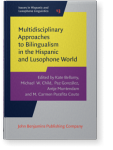Chapter 13
The global and the local
Making comparisons possible
Pieter Muysken | Centre for Language Studies, Radboud University & Language in Interaction Research Consortium
Article outline
- Portuguese-Spanish
-
The spread of Spanish and Portuguese as second languages
- Spanish and Portuguese in contact with other languages
- Dominant language-Heritage language
- Different techniques for studying code switching
- Future directions
-
Note
-
Abbreviations
-
References
References (27)
References
Baird, B. O. (2017). Prosodic transfer among Spanish-K’ichee’ bilinguals. In K. Bellamy, M. Child, P. González, A. G. Muntendam, & M. C. Parafita Couto (Eds.), Multidisciplinary approaches to bilingualism in the Hispanic and Lusophone world. Amsterdam: John Benjamins. 

Bakker, D., Gómez-Rendón, J. & Hekking, E. (2008). Spanish meets Guaraní, Otomí and Quichua: A multilingual confrontation. In T. Stolz, D. Bakker & R. Palomo (Eds), Aspects of language contact: New theoretical, methodological and empirical findings with special focus on romancisation processes (pp. 165–238). Berlin: Mouton de Gruyter.
Clements, J. C. (2009). The linguistic legacy of Spanish and Portuguese colonial expansion and language change. Cambridge: CUP. 

Eckert. P. (2009). Three waves of variation study: The emergence of meaning in the study of variation. Ms., Stanford University.
Hekking, E. & Muysken, P. (1995). Otomí y Quechua: Una comparación de los elementos prestados del español. In K. Zimmermann (Ed.), Lenguas en contacto en Hispanoamérica: Nuevos enfoques (pp. 111–118). Frankfurt: Vervuert.
Herzfeld, A. (1980). Creoles and standard languages: Contact and conflict. In P. H. Nelde (Ed.), Languages in contact and conflict (pp. 83–90). Wiesbaden: Steiner.
Irizarri van Suchtelen, P. (2016). Spanish as a heritage language in the Netherlands: A cognitive linguistic exploration. Unpublished PhD dissertation, Radboud University, Nijmegen.
Labov, W. (1972). Sociolinguistic patterns. Philadelphia, PA: University of Pennsylvania Press.
Marcelino, M. (2017). The Compounding Parameter and L2 acquisition. In K. Bellamy, M. Child, P. González, A. G. Muntendam, & M. C. Parafita Couto (Eds.), Multidisciplinary approaches to bilingualism in the Hispanic and Lusophone world. Amsterdam: John Benjamins. 

Moita Lopes, L. P. da (Ed.). (2013). O português no século XXI: Cenário geopolítico e sociolinguístico. São Paulo: Parábola.
Montrul, S. & Sánchez-Walker, N. (2013). Differential object marking in child and adult Spanish heritage speakers. Language Acquisition, 20(2), 109–132. 

Olbertz, H. (2005). Dizque en el español andino ecuatoriano: conservador e innovador. In: H. Olbertz & P. Muysken (Eds.), Encuentros y conflictos: Bilingüismo y contacto de lenguas en el mundo andino (Lengua y Sociedad en el Mundo Hispánico 14) (pp. 77–94) Madrid & Frankfurt: Iberoamericana & Vervuert.
Pfaff, C. (1979). Constraints on language-mixing: Intrasentential code-switching and borrowing in Spanish-English. Language, 55, 291–318. 

Poplack, S. (1980). “Sometimes I’ll start a sentence in Spanish y termino en español”: Toward a typology of code-switching. Linguistics, 18, 581–618. 

Salcedo, D. (2013). Defining Andeanness away from the Andes: Language attitudes and linguistic ideologies in Lima, Peru. Unpublished PhD dissertation, Ohio State University, Columbus.
Suárez, J. A. (1983). The Mesoamerican Indian Languages. Cambridge: CUP. 

van Osch, B., Hulk, A., Sleeman, P. & Aalberse, S. (2017). Knowledge of mood in internal and external interface contexts in Spanish heritage speakers in the Netherlands. In K. Bellamy, M. Child, P. González, A. G. Muntendam, & M. C. Parafita Couto (Eds.), Multidisciplinary approaches to bilingualism in the Hispanic and Lusophone world. Amsterdam: John Benjamins. 

Vergara-González, D., & López, L. (2017). Obliteration after Vocabulary Insertion. In K. Bellamy, M. Child, P. González, A. G. Muntendam, & M. C. Parafita Couto (Eds.), Multidisciplinary approaches to bilingualism in the Hispanic and Lusophone world. Amsterdam: John Benjamins. 

Cited by (1)
Cited by one other publication
Bellamy, Kate, Michael W. Child, Antje Muntendam & M. Carmen Parafita Couto
This list is based on CrossRef data as of 14 july 2024. Please note that it may not be complete. Sources presented here have been supplied by the respective publishers.
Any errors therein should be reported to them.
